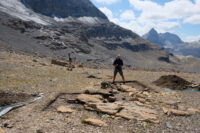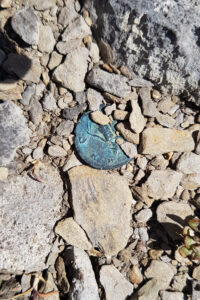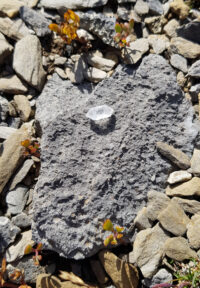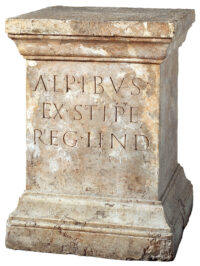 A surprising wealth of Roman artifacts believed to be votive offerings have been unearthed at a remote site high in the Alps in the Bern Canton of Switzerland. It was an intrepid off-piste hiker who discovered the site while climbing the Ammertenhorn peak in the summer of 2020. He came across a Roman bronze coin and informed the Archaeological Service of the Canton of Bern which then carried out excavations at the find site, a high plateau 8500 feet above sea level.
A surprising wealth of Roman artifacts believed to be votive offerings have been unearthed at a remote site high in the Alps in the Bern Canton of Switzerland. It was an intrepid off-piste hiker who discovered the site while climbing the Ammertenhorn peak in the summer of 2020. He came across a Roman bronze coin and informed the Archaeological Service of the Canton of Bern which then carried out excavations at the find site, a high plateau 8500 feet above sea level.
 In two dig seasons since the hiker’s lucky discovery, archaeologists have found a hundred more Roman coins struck from the 1st century to the 5th century A.D. The earliest is a coin of Tiberius 22-30 A.D.; the newest a coin of eastern emperor Arcadius (r. 395-408 A.D.). The team also unearthed 27 rock crystal stones, 59 Roman shoe hobnails, a fibula from the 1st century B.C. and a fragment of a bronze votive plate shaped like a leaf.
In two dig seasons since the hiker’s lucky discovery, archaeologists have found a hundred more Roman coins struck from the 1st century to the 5th century A.D. The earliest is a coin of Tiberius 22-30 A.D.; the newest a coin of eastern emperor Arcadius (r. 395-408 A.D.). The team also unearthed 27 rock crystal stones, 59 Roman shoe hobnails, a fibula from the 1st century B.C. and a fragment of a bronze votive plate shaped like a leaf.
“We do find single Roman coins occasionally in the Alps, but this site is unusual because of the amount of coins and the location,” Regula Gubler, the study’s scientific project manager, told Newsweek. “More common would be finds—coins, brooches—on mountain passes. This site however, is far from human habitation, today and in Roman times, at 2,590 meters above sea level [nearly 8,500 feet], and definitely not a pass.” […]
“We are only at the beginning of the investigations, but we think it is a holy place, where people went to deposit votive offerings—mainly coins, but also other objects—asking the deities for things or thanking them,” Gubler said. “I guess a kind of pilgrimage.”
 Comparable assemblages of these types of objects, particularly coins and rock crystals, have been found at Roman sanctuary sites, left as votive offerings by the devout. The rock crystals left at this site are naturally occurring on the mountain. They were likely not brought up there, but rather found and deposited. According to Pliny the Elder, rock crystals are ice that was frozen in the most intense cold. Alpine rock crystal, therefore, was the most highly prized of all. The prevalence of local rock crystal may have been part of the reason the location was seen as sacred.
Comparable assemblages of these types of objects, particularly coins and rock crystals, have been found at Roman sanctuary sites, left as votive offerings by the devout. The rock crystals left at this site are naturally occurring on the mountain. They were likely not brought up there, but rather found and deposited. According to Pliny the Elder, rock crystals are ice that was frozen in the most intense cold. Alpine rock crystal, therefore, was the most highly prized of all. The prevalence of local rock crystal may have been part of the reason the location was seen as sacred.
A site so hard to reach had to provide a powerful motivation to draw visitors. Even today archaeologists had to fly their supplies up and hike for hours from the closest trails and roads. The breathtaking location of the plateau — between the sharp snow-covered Ammertenhorn peak and the Wildstrubel massif — also may have inspired religious awe.
 We know that there was a Roman sanctuary in Allmendingen near Lake Thun just 12 miles away from the find site. From the 1st century A.D. until the Burgundian conquest of around 400 A.D., the Gallo-Roman population worshipped at an important cultic temple complex there. Votive inscriptions dedicated to Minerva, Mars, Diana, Mithras as well as local gods like Caturix and Rosmerta have been found in Allmendingen, and the Alps themselves were also invoked as deities. An altar base discovered in 1926 bears an inscription that dedicates the altar to the Alpine goddesses by the people of the “regio lindensis” (“lake region”).
We know that there was a Roman sanctuary in Allmendingen near Lake Thun just 12 miles away from the find site. From the 1st century A.D. until the Burgundian conquest of around 400 A.D., the Gallo-Roman population worshipped at an important cultic temple complex there. Votive inscriptions dedicated to Minerva, Mars, Diana, Mithras as well as local gods like Caturix and Rosmerta have been found in Allmendingen, and the Alps themselves were also invoked as deities. An altar base discovered in 1926 bears an inscription that dedicates the altar to the Alpine goddesses by the people of the “regio lindensis” (“lake region”).
The researchers will continue to study the site to find out more about its potential historical significance.
“It is an interesting site because it shows that the Roman population of the region didn’t only worship the mountains from afar, but also went up and close to them to deposit votive offerings,” Gubler said.